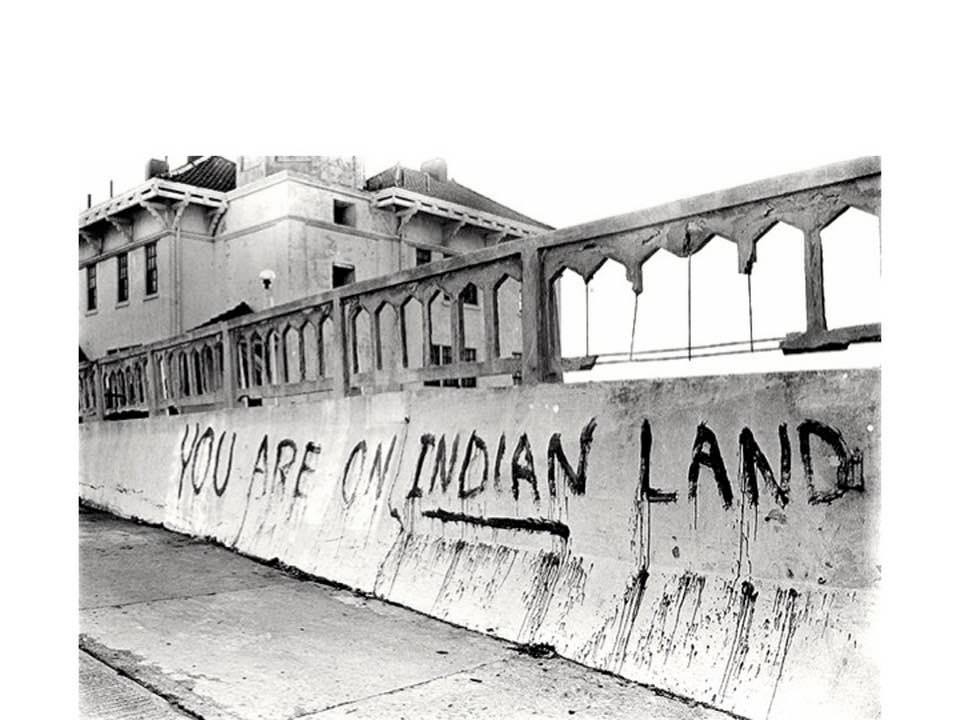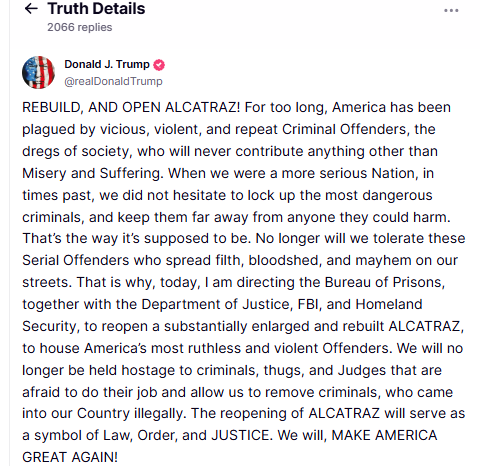
- Details
- By Levi Rickert
President Donald Trump posted on social media Sunday evening that he is directing his administration to reopen Alcatraz, the former maximum-security prision that closed six decades ago and later became a powerful symbol of Indigenous resistance.
Trump wrote on Truth Social that, "For too long, America has been plagued by vicious, violent and repeat Criminal Offenders, the dregs of society, who will never contribute anything other than Misery and Suffering. When we were a more serious Nation, in times past, we did not hesitate to lock up the most dangerous criminals, and keep them far away from anyone they could harm. That's the way it's supposed to be."
Upon his arrival back to the White House on Sunday evening, Trump said reopening Alcatraz was “just an idea I’ve had” amid mounting discontent over “radicalised judges” who have insisted those being deported receive due process.
“It’s a symbol of law and order,” he said.
Even before it was a federal penitentiary, Alcatraz island, located just over a mile from San Francisco, was used to house prisoners. In 1895, when 50 Hopi parents refused to send their children to Indian boarding schools, they were arrested and imprisoned at Alcatraz. The San Francisco Chronicle reported that “[n]ineteen murderous-looking Apache Indians” had been jailed at Alcatraz, “because they would not let their children go to school.”
From August 11, 1934 until March 21, 1963, Alcatraz Island was the site of a federal penitentiary, famously nicknamed "The Rock." Among its most notorious inmates was gangster Al Capone.
Alcatraz Federal Penitentiary had the capacity to hold 336 inmates, though its average population typically ranged between 260 and 275 prisoners at any given time.
During its 29 years of operation, there were 14 recorded escape attempts involving 36 men. Of those, 23 were recaptured, six were shot and killed, and two drowned. The prison ultimately closed on March 21, 1963, due to high operating costs, according to the Bureau of Prisons.
After its closure, the island was largely abandoned—until 1969, when a group of Native American activists occupied Alcatraz for 18 months, declaring it Indian land in a powerful act of protest.
On November 20, 1969, a group of 89 Native Americans from various tribes arrived by boat and claimed Alcatraz Island as Indigenous territory. The group, primarily composed of students, formed the organization Indians of All Tribes, which remains active today.
The activists occupied the island for 19 months, resisting eviction orders from President Richard Nixon’s administration, the U.S. Coast Guard, and other federal authorities. Their bold stand drew national and international attention.
“After centuries of broken treaties, brutal injustice, and government policies aimed at erasing Native culture and identity, this action was a powerful fight for survival,” Dr. LaNada War Jack, one of the original student occupiers said. “By reclaiming Alcatraz, we brought attention to our struggle and sparked a global conversation.”
In 1972, Congress established the Golden Gate National Recreation Area, incorporating Alcatraz Island into the National Park Service. By fall 1973, Alcatraz was opened to the public and quickly became one of the most visited National Park Service sites in the country. It continues to operate as a major tourist destination to this day.
For over 50 years, Native Americans have held sunrise rallies on Alcatraz Island on Indigehous Peoples Day and Thanksgiving.
In November 2021, Native American activists from the group Indians of All Tribes renewed their call to establish a Native American cultural center on Alcatraz. The proposed center would create a permanent Indigenous presence on the island, offering a space for cultural education, community gatherings, and storytelling. The vision supports the National Park Service’s commitment to honoring Indigenous history as an essential part of the American story.
In response to recent discussions about possibly reopening the prison, former House Speaker Nancy Pelosi, a Democrat representing the district that includes Alcatraz, dismissed the idea. "It is now a very popular national park and major tourist attraction. The President's proposal is not a serious one," she wrote on X (formerly Twitter).
More Stories Like This
Native News Weekly (August 25, 2024): D.C. BriefsUS Presidents in Their Own Words Concerning American Indians
Native News Weekly (December 7, 2025): D.C. Briefs
Why We Report: Chez Oxendine Shares His Story for Native News Online’s Year-End Campaign
New Amnesty International Report Details Torture, Overcrowding at Krome and ‘Alligator Alcatraz’
Help us defend tribal sovereignty.
At Native News Online, our mission is rooted in telling the stories that strengthen sovereignty and uplift Indigenous voices — not just at year’s end, but every single day.
Because of your generosity last year, we were able to keep our reporters on the ground in tribal communities, at national gatherings and in the halls of Congress — covering the issues that matter most to Indian Country: sovereignty, culture, education, health and economic opportunity.
That support sustained us through a tough year in 2025. Now, as we look to the year ahead, we need your help right now to ensure warrior journalism remains strong — reporting that defends tribal sovereignty, amplifies Native truth, and holds power accountable.
 The stakes couldn't be higher. Your support keeps Native voices heard, Native stories told and Native sovereignty defended.
The stakes couldn't be higher. Your support keeps Native voices heard, Native stories told and Native sovereignty defended.
Stand with Warrior Journalism today.
Levi Rickert (Potawatomi), Editor & Publisher



